The Gem Cluster (NGC 3293) is a young open cluster located approximately 8,400 light-years away in the southern constellation Carina (the Keel). With an apparent magnitude of 4.7 and an apparent size of 13 arcminutes, the cluster is visible in small telescopes. It is also catalogued as Collinder 224 and Melotte 100.
NGC 3293 has a mass of 1,457 solar masses and is only 12 million years old. It contains more than a hundred stars brighter than 14th magnitude within a field 10 arcminutes across. The cluster itself has a radius of 13.2 light-years. It appears northwest of the Carina Nebula, one of the brightest and largest stellar nurseries in the sky.
The brightest members of the Gem Cluster are hot blue supergiants. The blue supergiant HD 91969 (spectral class B0 Ib) is the brightest star in the cluster. It shines at magnitude 6.51. With an estimated mass of 40 solar masses, the behemoth star is a supernova candidate.
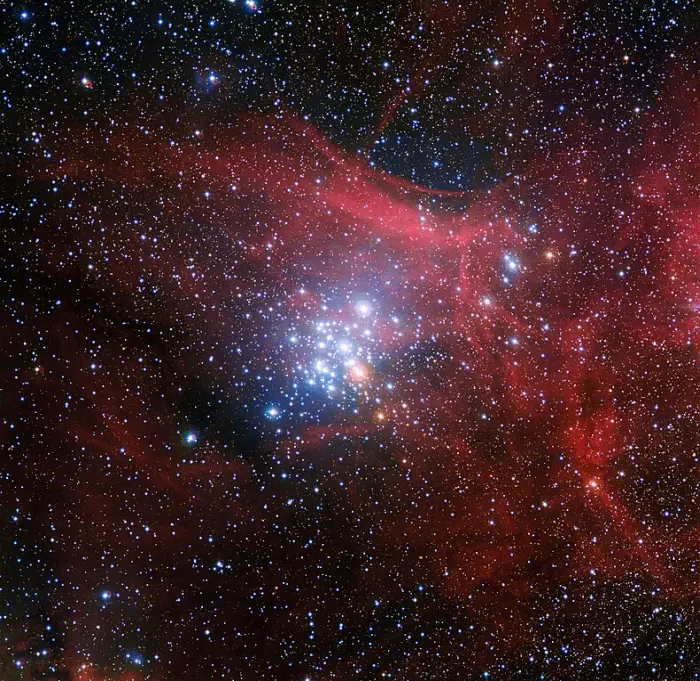
In this image from the Wide Field Imager on the MPG/ESO 2.2-metre telescope at ESO’s La Silla Observatory in Chile young stars huddle together against a backdrop of clouds of glowing gas and lanes of dust. The star cluster, known as NGC 3293, would have been just a cloud of gas and dust itself about ten million years ago, but as stars began to form it became the bright group we see here. Clusters like this are celestial laboratories that allow astronomers to learn more about how stars evolve. Credit: ESO/G. Beccari (CC BY 4.0)
The second brightest star, the blue supergiant HD 91943 (B0.7 Ib) has an apparent magnitude of 6.69. With an estimated mass 30 times that of the Sun, it will also meet its end as a fiery supernova.
The cluster also hosts a pulsating red supergiant, V361 Carinae (M1.5Iab-Ib), which is a seventh magnitude star.
The Gem Cluster is associated with the nearby open cluster NGC 3324 and the emission nebula IC 2599. NGC 3324 and IC 2599 are jointly referred to as the Gabriela Mistral Nebula, after the Chilean poet. NGC 3324 lies 9,100 light-years away and has a radius of 15 light years.
Both NGC 3293 and NGC 3324 are around 12 million light-years old and show a degree of mass segregation. The more massive members of the cluster are concentrated near the clusters’ centres. The two clusters form a binary cluster. They are separated by 62 light-years (19 parsecs).
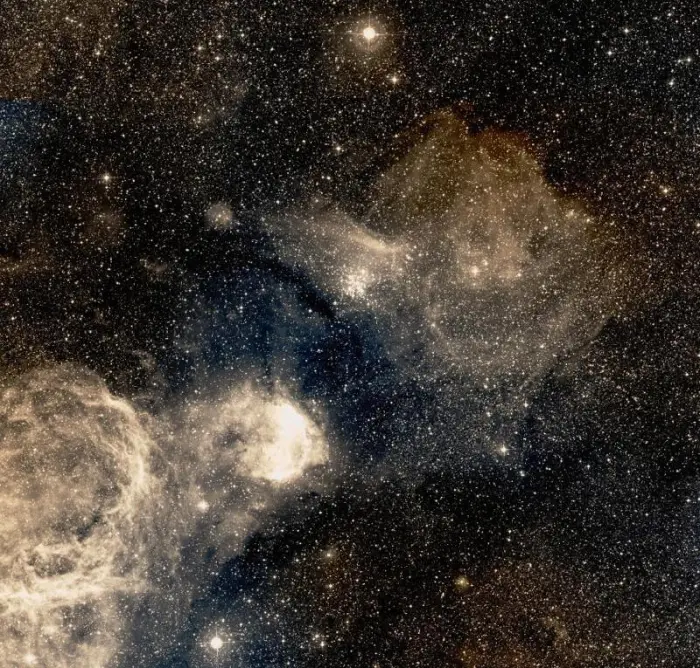
The Gem Cluster (NGC 3293, just above centre) and the Gabriela Mistral Nebula (NGC 3324, bright patch just below centre) image credit: ESO/Digitized Sky Survey 2 (CC BY 4.0)
The Gem Cluster is associated with a faint nebulosity that is an extension of the bright Carina Nebula. It lies at the northwestern edge of the Carina Nebula complex, one of the most massive active star forming regions in the Milky Way.
The entire complex stretches around 326 light-years (100 parsecs) across and has a mass of 10 million Suns. It is home to more than 100,000 young stars. The Gem Cluster is separated by 1.5 degrees from the centre of its brightest portion, the famous Carina Nebula.
Facts
The Gem Cluster was discovered by the French astronomer Nicolas Louis de Lacaille from the Cape of Good Hope in South Africa in 1751.
The stars of the Gem Cluster and the Carina Nebula are members of the Carina OB1 stellar association. The stellar family contains some of the most massive and luminous stars in our galaxy, including the luminous blue variable Eta Carinae, the Wolf-Rayet stars WR 22 and WR 25, and the blue supergiant HD 93129. The association stretches about 70 light-years across and is enveloped in an active emission nebula.
Observations with the Chandra X-ray Observatory in 2017 indicated that the Gem Cluster contains a large population of stars with masses similar to the Sun’s.
A comprehensive 2021 study identified 692 probable members of NGC 3293 and determined an age of 12 ± 2 million years for the cluster. The study was based on Gaia EDR3 astrometric data and the data obtained in the Wide-field Infrared Survey Explorer (WISE), the AAVSO Photometric All-Sky Survey (APASS), the VISTA Variables in the Vía Láctea (VVV) survey, the VST/Omegacam Photometric Hα Survey (VPHAS), and the Galactic Legacy Infrared Mid-Plane Survey (GLIMPSE) with the Spitzer Space Telescope.
Previous age estimates for the cluster were in the range from 7-10 million years. The same team determined a total mass of 1,457 Suns for the cluster, with a mass range between 1.1 and 6.8 solar masses and a mean mass of 2.10 solar masses.
The astronomers found that NGC 3293 and NGC 3324 formed a binary cluster and that they were not dynamically relaxed. The small separation between the two clusters – 62 light-years (19 parsecs) – indicates that they are gravitationally bound.
A 2022 spectroscopic study of the Gem Cluster found an age of 20 million years for the cluster, which is significantly older than previous estimates. This would make NGC 3293 the oldest grouping of stars in the Carina Nebula complex.
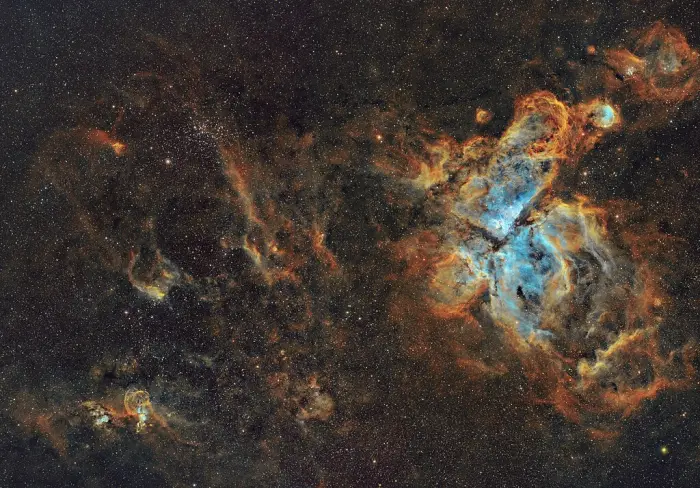
In this wide-field 1×2 mosaic we can see NGC 3576 (Statue of Liberty Nebula) in the lower left margin, the star cluster NGC 3532 (Wishing Well) in the upper left margin, and the Great Carina Nebula (NGC 3372) in the center, in the upper right margin the Gabriela Mistral Nebula (NGC 3324). and the Gem Cluster (NGC 3293). Image credit: Wikimedia Commons/Cappellettiariel (CC BY-SA 4.0)
Location
The Gem Cluster appears in the region near the Diamond Cross, the faintest of the three diamond-shaped asterisms in the far southern sky. The Diamond Cross is formed by Miaplacidus with Theta, Upsilon and Omega Carinae. It appears between the larger False Cross, formed by Avior, Aspidiske, Alsephina, and Markeb, and the smaller and brighter Southern Cross, formed by Acrux, Mimosa, Gacrux, Imai, and Ginan.
The Gem Cluster can be found along the imaginary line extended from Canopus, the second brightest star in the sky, through Avior, Carina’s third brightest star. The cluster appears more than halfway from Gacrux (Gamma Crucis), the star at the top of the Southern Cross) to Markeb (Kappa Velorum) in the False Cross.
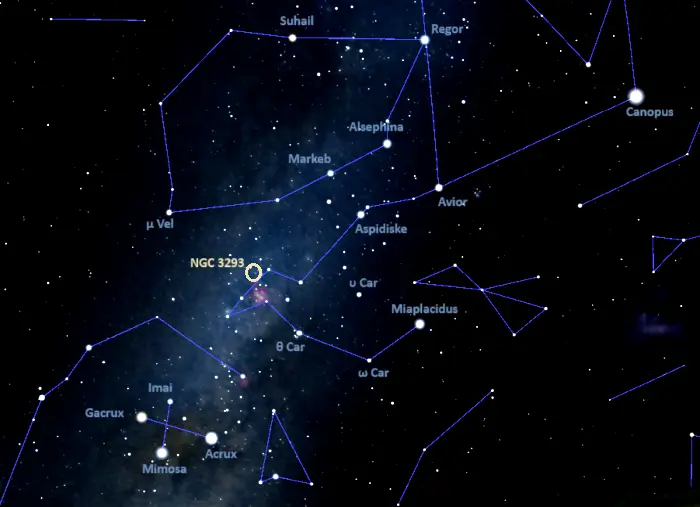
The location of the Gem Cluster (NGC 3293), image: Stellarium
The brightest stars of NGC 3293 appear less a degree northwest of the Carina Nebula and less than 2 degrees northwest of the massive star system Eta Carinae. They can be seen in binoculars. The cluster is visible to the unaided eye, appearing as a fuzzy star in good conditions. A small telescope will resolve dozens of its brightest stars.
The region of the Diamond Cross is full of other bright and well-known deep sky objects. These include the famous Carina Nebula (NGC 3372), the Wishing Well Cluster (NGC 3532), the Whirling Dervish Nebula (NGC 3247), the Banana Nebula (NGC 3199), the Southern Pleiades (the Theta Carinae Cluster, IC 2602), the Statue of Liberty Nebula (NGC 3576), and the open clusters IC 2581 and the Hand Cluster (NGC 3114).
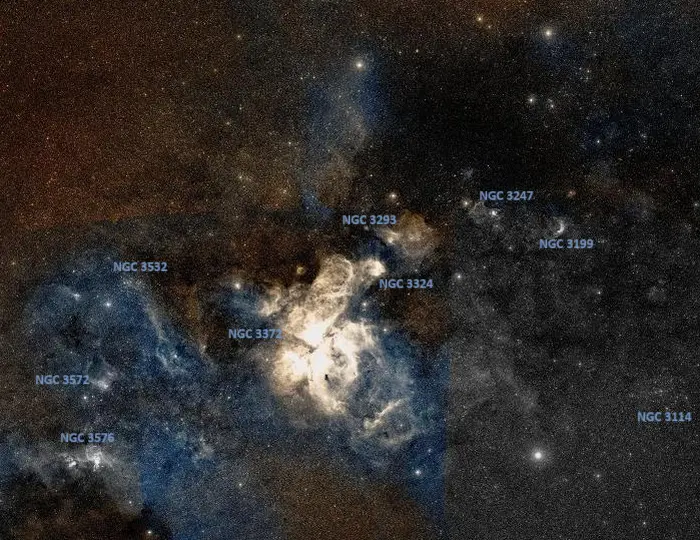
NGC 3293, the Gabriela Mistral Nebula (NGC 3324 and IC 2599), the Carina Nebula (NGC 3372), the Wishing Well Cluster (NGC 3532), the Whirling Dervish Nebula (NGC 3247), NGC 3572, the Statue of Liberty Nebula (NGC 3576), the Hand Cluster (NGC 3114), and the Banana Nebula (NGC 3199), image credit: ESO/Digitized Sky Survey 2 (CC BY 4.0)
At declination -58°, the Gem Cluster never rises above the horizon for observers north of the latitude 31° N and stays low above the horizon for observers in the northern tropical latitudes.
The best time of the year to observe NGC 3293 and other deep sky objects in Carina is during the month of March, when the constellation appears higher in the sky in the early evening.
Gem Cluster – NGC 3293
| Constellation | Carina |
| Object type | Open cluster |
| Right ascension | 10h 35m 52.8s |
| Declination | −58° 13′ 52′′ |
| Apparent magnitude | 4.7 |
| Apparent size | 13′ x 13′ |
| Distance | 8,400 light-years (2,590 parsecs) |
| Age | 12 ± 2 million years |
| Radius | 13.2 light-years |
| Mass | 1,457 M☉ |
| Names and designations | Gem Cluster, NGC 3293, Collinder 224 (Cr 224), Melotte 100 (Mel 100), BRAN 316C, C 1033-579, VDBH 98, GUM 30, OCl 816.0, Raab 85, RCW 51, MWSC 1826 |